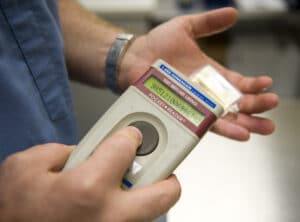
Microchipping – Your Questions Answered.
One of the worst feelings in the world comes when you can’t find your pet. This is your baby, your furry friend, your family. One of the best ways to prepare for this possibility is to microchip your pet. We answer below some commonly asked questions about microchipping.
 Why should my pets be chipped?
Why should my pets be chipped?
A study found that lost dogs are 2 1/2 times, and lost cats are 20 times more likely to get home when they have an UPDATED microchip. Collars and tags are great as well as necessary. However, they can get broken or lost, and since a microchip is inside your pet, it will not be lost. According to Dallas City Laws, if a pet is found and impounded, without identification the pet is only held for three days before being adopted out; with identification (ID tag and/or a microchip), the pet hold goes up to 5 days if you live outside Dallas make sure you check the laws in your area.
Are your pet’s chipped?
Microchips are as tiny as a grain of rice and hold a unique ID number that a vet or shelter can read. If you got your pet from a shelter, there is a good chance that they have a microchip, although it is always good to ask. If you got a new pet or know that they don’t already have a microchip, the procedure to insert a microchip is as simple as a vaccination and can be done by your vet. The microchip is inserted under the loose skin between your pet’s shoulder blades, and since there are no batteries or power required, it should be good for the life of your pet.
 When was the last time you updated that information?
When was the last time you updated that information?
Microchips literally only have a unique ID number; it doesn’t do the vet or shelter any good unless it is registered AND updated. There are many pet registry sites out there, for a free place to register your pet go to Found Animals, the one we like that gives you several benefits is HomeAgain. For an annual membership of $19.99/year, your pet will be entered in a national database, give you access to a Lost Pet Specialist, send out Pet Alerts when you report your pet missing, gives you access to an Emergency Medical Hotline, and provides Travel Assistance for pets found very far from home. To facilitate your pet coming safely home to you, it is important that you update your contact information if anything changes, and we recommend that you update your information annually.
Do you have the microchip number written down and accessible?
It is a good idea to have this information accessible in order to update your information easily or if your pet is lost. To get this information, if you adopted from a shelter/rescue, they might have this information handy; if not, your vet might have the information, or you can take your pet into your vet’s office, animal shelter, or animal control to have them scan the chip and get the information. It’s also good to know the brand of microchip, you can find this on AAHA Universal Pet Microchip Lookup site, this site will also tell you which registry the chip is registered, when it was last updated, and give you information on how to get in touch and update your information.
What else should I know about microchipping?
Microchips ARE NOT GPS. Microchips are inserted inside your pet, do not require any batteries, and do not show the pet’s location. Microchips have an ID number that helps whoever finds your pet to find you! In addition to your contact information and the contact information of all other owners in the household, the registry should have a contact of someone not in the household (and even out of the vicinity) as an emergency contact. Tornados, heavy storms, and other natural disasters can cause power outages and cell tower/phone outages, and they are also a perfect recipe for creating lost pets! If the only contact information is someone you know in your area, it may be challenging to get a hold of listed contacts. Another essential thing to note is that you should have your pet’s chips scanned every time they go. It is rare, but sometimes the microchip in pets can migrate to a different part of the body. It is a good idea to check for this occasionally because if the microchip is not in the “normal” spot or hard to find, then your pet might not be scanned if lost. Again, because this is rare, your 1st microchip will most likely work for the life of your pet, check here for reasons you might want to re-chip your pet.
We sincerely hope that you never have to experience a lost pet, but if you do, we hope that this information can help you retrieve your pet a bit faster. Here are some stories of pets that have been reunited with their families because of microchipping:
- Lost dog reunited with family quickly thanks to Lincoln animal control, microchip implant
- Saved by a microchip
- This dog jumped from a car and disappeared for 9 months. How did he find his way home?
- Microchip Leads Cat Missing For Over 5 YEARS Back To One Happy & Shocked Family!
References:
‘Second Microchips: Should You Re-Chip Your Pet?’, Found Animals. Available at: https://www.foundanimals.org/second-microchips-re-chip-pet/ (Accessed: 2 May 2019)
‘Dallas Pet Laws’, Dallas City Hall. Available at: https://dallascityhall.com/departments/dallas-animal-services/Pages/Pet-Laws.aspx (Accessed: 2 May 2019)
‘How do Microchips Work’, American Kennel Club. Available at: https://www.akc.org/expert-advice/lifestyle/how-do-dog-microchips-work/ (Accessed: 2 May 2019)
‘Microchipping Facts’, HomeAgain. Available at: https://www.homeagain.com/microchipping-facts.html (Accessed: 2 May 2019)
